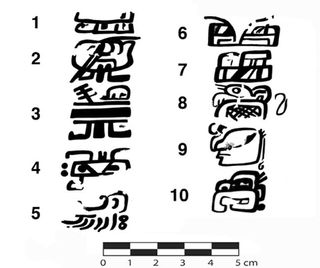Earliest Maya Writings Found

Newly discovered hieroglyphs show that the Maya were writing at a complex level 150 years earlier than previously thought.
The glyphs, which date to about 250 BC, were found on preserved painted walls and plaster fragments in the pyramidal structure known as Las Pinturas, in San Bartolo, Guatemala.
Las Pinturas also yielded the previously oldest samples of Maya writing, dating back to 100 BC.
New World slower
Writing emerged in Mesopotamia, Egypt, and India as far back as 3,000 BC. Yet the first full-blown text—a series of signs that are clearly telling a story—don't show up in the New World until about 400-300 BC. They were left by the Zapotecs in the Oaxaca valley south of central Mexico. Most of the early Maya writing comes from 150-250 AD.
Because Zapotec writing emerged so much earlier, researchers have long believed that the Mayas were influenced by it.
The earliest single Maya glyph—which could have stood for a person's name or been a sign on a calendar—dates to about 600 BC. But it isn't considered writing. These new glyphs are much more complex, said project leader William Saturno of the University of New Hampshire.
Sign up for the Live Science daily newsletter now
Get the world’s most fascinating discoveries delivered straight to your inbox.
"This is a full blown and fully developed script," Saturno told LiveScience. "Which is not to say that the Maya invented writing and not the Zapotec, but it does lead us to question the origins and the complexities of these origins."
One thing seems certain: The Maya style was not influenced by the Zapotecs.
"It's not similar at all to Zapotec," Saturno said. "You have these roughly contemporary examples that are completely different, which implies a more complex history than simple derivation."
Say what?
Despite being clearly developed written text, the newfound work cannot yet be read by scientists.
"Between 200 and 300 AD is when we become literate in Maya writing," Saturno said. "It's definitely writing, though, no question about that. Some of these signs are consistent with Maya writing for the next 1,000 years."
For example, glyph 7 is an early version of "AJAW," a symbol ubiquitously used with kings' names that means "lord, noble, or ruler." Glyph 2 has vague pictorial qualities and may suggest a hand holding a brush or a sharp knife-like object.
Firm date
A common problem with dating Maya writing is that it is often on stone, which scientists can't accurately date using radiocarbon dating. Instead, they must use stylistic changes to date materials.
However, Saturno and his team found these writings in a pyramid made in part with wood, which is carbon based and can be dated with radiocarbon techniques.
"The way the Maya built pyramids is by building one layer on top of another," Saturno said. "We have [the building where the writing was found] sandwiched between two other buildings. We can get a date from the building itself, but also a range from the other two."
Taken together, these samples imply that the text was painted between 300 and 200 BC. But it's likely that Maya writing goes back a lot further, Saturno said.
"Given the grace, form, and consistent line-width of these symbols, it's not likely someone just picked up a brush and said 'I'm going to invent writing today,'" Saturno said. "This complexity shows it had been around for a while."
This research is detailed in the Jan. 5 online edition of the journal Science.
- The Greatest Modern Minds
- Incan Words Tied Up In Knots
- Apparent Writing from 10th Century B.C. Found
- Ancient Mayan Canals Possibly Spotted in Satellite Images
- Evidence May Back Human Sacrifice Claims
Most Popular



